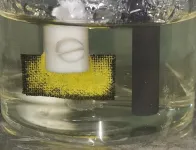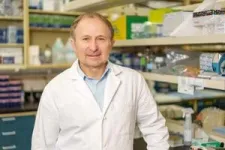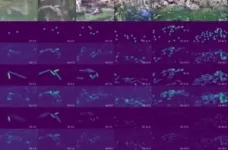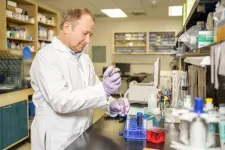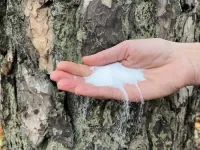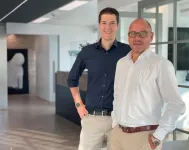Extracting uranium from seawater as another source of nuclear fuel
2023-12-13
(Press-News.org) Oceans cover most of Earth’s surface and support a staggering number of lifeforms, but they’re also home to a dilute population of uranium ions. And — if we can get these particular ions out of the water — they could be a sustainable fuel source to generate nuclear power. Researchers publishing in ACS Central Science have now developed a material to use with electrochemical extraction that attracts hard-to-get uranium ions from seawater more efficiently than existing methods.
Nuclear power reactors release the energy naturally stored inside of an atom and turn it into heat and electricity by literally breaking the atom apart — a process known as fission. Uranium has become the favored element for this process as all its forms are unstable and radioactive, making it easy to split. Currently, this metal is extracted from rocks, but uranium ore deposits are finite. Yet, the Nuclear Energy Agency estimates that 4.5 billion tons of uranium are floating around in our oceans as dissolved uranyl ions. This reserve is over 1,000 times more than what’s on land. Extracting these ions has proven to be challenging, though, as the materials for doing so don’t have enough surface area to trap ions effectively. So, Rui Zhao, Guangshan Zhu and colleagues wanted to develop an electrode material with lots of microscopic nooks and crannies that could be used in the electrochemical capture of uranium ions from seawater.
To create their electrodes, the team began with flexible cloth woven from carbon fibers. They coated the cloth with two specialized monomers that were then polymerized. Next, they treated the cloth with hydroxylamine hydrochloride to add amidoxime groups to the polymers. The natural, porous structure of the cloth created many tiny pockets for the amidoxime to nestle in and easily trap the uranyl ions. In experiments, the researchers placed the coated cloth as a cathode in either naturally sourced or uranium-spiked seawater, added a graphite anode and ran a cyclic current between the electrodes. Over time, bright yellow, uranium-based precipitates accumulated on the cathode cloth.
In the tests using seawater collected from the Bohai Sea, the electrodes extracted 12.6 milligrams of uranium per gram of water over 24 days. The coated material’s capacity was higher than most of the other uranium-extracting materials tested by the team. Additionally, using electrochemistry to trap the ions was around three times faster than simply allowing them to naturally accumulate on the cloths. The researchers say that this work offers an effective method to capture uranium from seawater, which could open up the oceans as new suppliers of nuclear fuel.
The authors acknowledge funding from the National Key R&D Program of China, the National Natural Science Foundation of China, the Project of Education Department of Jilin Province, the Natural Science Foundation of Department of Science and Technology of Jilin Province, the Fundamental Research Funds for the Central Universities, and the “111” project.
The paper’s abstract will be available on Dec. 13 at 8 a.m. Eastern time here: http://pubs.acs.org/doi/abs/10.1021/acscentsci.3c01291
###
The American Chemical Society (ACS) is a nonprofit organization chartered by the U.S. Congress. ACS’ mission is to advance the broader chemistry enterprise and its practitioners for the benefit of Earth and all its people. The Society is a global leader in promoting excellence in science education and providing access to chemistry-related information and research through its multiple research solutions, peer-reviewed journals, scientific conferences, eBooks and weekly news periodical Chemical & Engineering News. ACS journals are among the most cited, most trusted and most read within the scientific literature; however, ACS itself does not conduct chemical research. As a leader in scientific information solutions, its CAS division partners with global innovators to accelerate breakthroughs by curating, connecting and analyzing the world’s scientific knowledge. ACS’ main offices are in Washington, D.C., and Columbus, Ohio.
To automatically receive news releases from the American Chemical Society, contact newsroom@acs.org.
Note: ACS does not conduct research, but publishes and publicizes peer-reviewed scientific studies.
Follow us: Twitter | Facebook | LinkedIn | Instagram
END
ELSE PRESS RELEASES FROM THIS DATE:
2023-12-13
The vast majority of older adults – 83% -- think health insurers should cover medications that can help people with obesity manage their weight, a new poll of people age 50 to 80 finds.
Nearly as many -- 76% -- believe Medicare should cover these drugs, which it cannot currently do under law, according to the new results from the University of Michigan National Poll on Healthy Aging.
A law passed in 2003 prohibits Medicare from covering weight loss medications, though it can cover drugs to help people with Type 2 diabetes manage their weight. Medicaid covers obesity medications ...
2023-12-13
With an estimated 1.9 million new cases and more than 600,000 deaths each year, cancer remains the second most common cause of death in the U.S., trailing only heart disease. And while there are more than 200 types of cancer, the abnormal synthesis of a protein known as STAT3 is unique to the majority of tumors.
STAT3 is known as a transcriptional regulator, which means it regulates the expression of several genes. In fact, STAT3 is associated with approximately 70% of all human tumors and is responsible for uncontrolled cell growth and disease progression.
To investigate new approaches to inhibit STAT3 and develop new cancer treatments, the National Institutes of Health-National ...
2023-12-13
Flat-faced dog breeds are popular all over the world. In the USA and in Hungary, the French Bulldog is currently the most common breed. However, their popularity comes at a high cost in terms of health: shortened skulls are associated with deteriorative brain morphology changes, breathing difficulties and sleep problems. According to recent findings by Hungarian researchers, flat-faced dogs sleep more because their breed-specific sleep apnea increases daytime sleepiness, their REM sleep phase is longer than ...
2023-12-13
The University of Texas at San Antonio today announced the selection of David Brown as the new executive director of its National Security Collaboration Center (NSCC) and professor of practice. Brown will join UTSA with decades of experience leading collaborative research and development ecosystems supporting U.S. national defense strategies.
Brown is a trusted, well-connected leader in civilian and military communities nationwide who has especially strong relationships within U.S. Department of Defense (DoD) organizations, laboratories and commands and has gained national recognition for his transformative leadership in federal research ...
2023-12-13
Studies on sustainability inevitably touch on food-related topics like food security, culinary heritage, and the sustenance of vulnerable people. Social sustainability is one of the three pillars of sustainability, alongside environmental and economic sustainability, and has become a pivotal topic in various research fields. It includes concerns about social justice, resource distribution and recognition, and political participation of marginalized groups at the local community level.
Very few studies of social sustainability have looked at urban foodways in terms of social and cultural infrastructure. More often than not, scholars in Japan have ...
2023-12-13
The transition to a society without fossil fuels means that the need for batteries is increasing at a rapid pace. At the same time, the increase will mean a shortage of the metals lithium and cobalt, which are key components in the most common battery types. One option is a sodium-ion battery, where table salt and biomass from the forest industry make up the main raw materials. Now, researchers from Chalmers University of Technology, Sweden, show that these sodium-ion batteries have an equivalent climate impact as their lithium-ion counterparts – without the risk of running out of raw materials.
"The materials ...
2023-12-13
Research Highlights:
An analysis of death certificate data from 1999 to 2020 showed a decline in deaths related to infective endocarditis throughout most of the United States yet found an alarming increase of 2%-5% among adults ages 25-44.
There was a notable increase in the diagnosis of substance use disorder among the young adults with infective endocarditis listed as the underlying cause of death.
Three states at the epicenter of the opioid crisis— Kentucky, Tennessee and West Virginia — had significant increases in death rates related to infective endocarditis.
Embargoed until 4 a.m. CT/5 a.m. ET Wednesday, Dec. 13, 2023
DALLAS, Dec. 13, 2023 — ...
2023-12-13
Smartwatches can help physicians detect and diagnose irregular heart rhythms in children, according to a new study from the Stanford School of Medicine.
The finding comes from a survey of electronic medical records for pediatric cardiology patients receiving care at Stanford Medicine Children’s Health. The study will publish online Dec. 13 in Communications Medicine.
Over a four-year period, patients’ medical records mentioned “Apple Watch” 145 times. Among patients whose medical records mentioned ...
2023-12-13
VANCOUVER, Wash. – Even in the precipitation-heavy Pacific Northwest, more frequent heatwaves are threatening a key source of water supply.
A Washington State University study that intended to look at snow melting under a single, extreme event, the 2021 “heat dome,” instead revealed an alarming, longer-term rising trend of successive heatwaves melting snowpack earlier in the year.
The findings have implications for many areas worldwide that are dependent on snow-capped mountains to provide summer water since heatwaves have been on the rise globally.
“Short-term ...
2023-12-13
Barcelona and Johannesburg, December 13th, 2023
The Scientific Group, a leader in the IVD industry, and Inbiomotion, a company commercializing its proprietary MAF Test® for identifying high risk early-stage breast cancer patients have signed an agreement to start marketing MAF Test® in Sub-Saharan Africa. The MAF Test® predicts the prognosis of breast cancer patients and helps oncologists to identify those patients who may be able to prevent recurrence and benefit from adjuvant treatment with bisphosphonates, which are commonly used to treat osteoporosis. The test also identifies those patients whose prognosis would worsen if treated with bisphosphonates.
Breast ...
LAST 30 PRESS RELEASES:
[Press-News.org] Extracting uranium from seawater as another source of nuclear fuel
